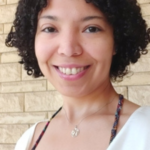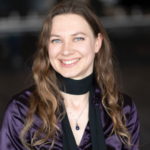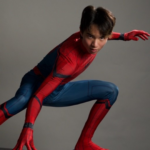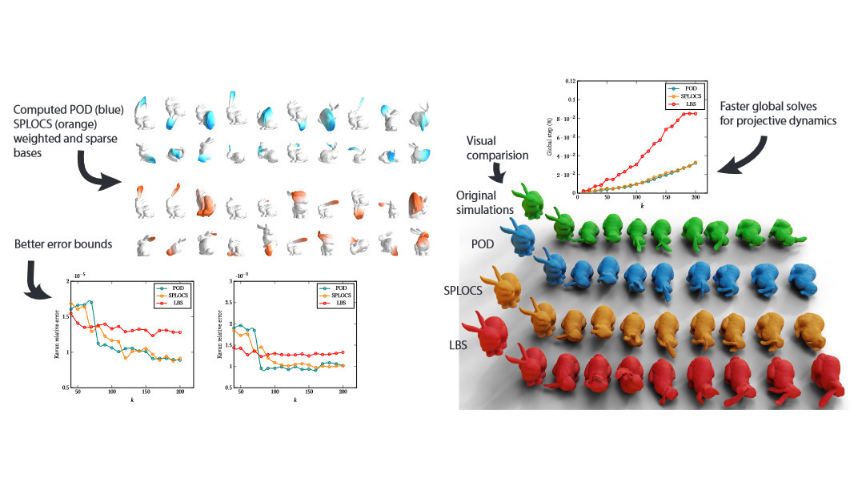Image credit © Shaimaa Monem, MPI Magdeburg.
Congratulations to the winners of the SIGGRAPH 2023 Student Research Competition, Shaimaa Monem Abdelhafez (first place), Jessica Baron (second place), Timothy Chen (third place), and Kensuke Katori (first place, undergraduate), on their hard work presenting their original research in front of a panel of experts in computer graphics and interactive techniques. Read below for a more in-depth look into the next generation of professionals.
SIGGRAPH: Congratulations on being one of the winners of the SIGGRAPH 2023 Student Research Competition! Talk a bit about what inspired your poster.
Shaimaa Monem Abdelhafez (SMA): My background is in numerical and applied mathematics, and in my PhD study, the main joyful part is exploring and implementing techniques to accelerate some simulations of interest. Around two years ago I developed a curiosity about applications in computer graphics which was very far from my research direction back then. Therefore, I was searching and reading many papers regarding the useful techniques used in CG for expediting physics simulations, aiming to find common ground between CG applications and dimensionality reduction which is the core of my PhD project.
I started a side project where I kept trying to put bits and pieces together until it felt like I had a concrete idea of what I wanted to try and what value I could add. Then I proposed it to my supervisor who was excited about the idea and told me it would be great if it worked, and this is how I started.
Jessica Baron (JB): The motivation behind the work in my poster is my main PhD dissertation topic of studying the appearance of feathers for computer graphics. Feathers are unique and complex structures, and my advisor, Dr. Eric Patterson, and I decided to treat their light-scattering behavior as spatially varying scattering distribution functions (SVBSDFs). This idea led to the creation of an SVBSDF-acquisition pipeline for our custom, multi-purpose light sphere (named VarIS).
Kensuke Katori (KK): I am truly honored. My poster revolved around re-examining an optical element, which is a special mirror used in retinal projection. By changing the whole material, we aimed to maintain the retinal projection feature while increasing the transmittance of the optical elements.
The inspiration for this project stemmed from our lab’s research at SIGGRAPH 2018 titled “Make Your Own Retinal Projector.” Delving deeper, the core inspiration came from AR glasses. At the age of 12, I happened upon Google Glass, and since then, I’ve been enthralled by AR glasses and the very concept itself. Later on, I learned about Yoichi Ochiai’s Digital Nature Group’s research on retinal projection AR devices. I felt that this would undoubtedly evolve into the pinnacle of AR glasses, which led me to join this lab and conduct this research.
SIGGRAPH: What was the most challenging aspect of conducting or analyzing your study?
SMA: After lots of reading, I figured that although snapshot methods can be very accurate in dynamics simulations, people usually avoid using them because they are heavy on memory. It is a method that uses information from the original solution of the model in order to formulate faster approximation, and this is why it captures the key features in the simulations. I started a series of questions like: What if we try utilizing sparse bases, how can we make sure the reduced simulation is still capable of expressing translation and rotation simultaneously, and so on. Of course I exploited some of the beautiful ideas in the literature and stretched some in order to reach a convenient working algorithm and compared to the state of the art.
In addition, a big challenge was that computer graphics applications were not common in my research group. For a long while I was working independently, which also was an amazing path for learning and deeply understanding the details of the topic I proposed. While I was very excited in the process and I was very motivated to join the graphics community, I started volunteering in summer schools and going to conferences in order to build connections, collaborate, and put together new projects. Now I am officially part of the community, and I am eager to continue contributing to it for the foreseeable future.
JB: The most challenging aspect of my study is learning and understanding the components involved — theory, hardware, and software — in establishing the capture system and material-acquisition pipeline in addition to contributing something new to the field of graphics.
KK: One of the most challenging aspects was selecting the right materials. This project was conducted with a tight budget of just $300 because I tried to manage within the budget I secured. Therefore, it was crucial to find materials that were affordable yet met the necessary optical specifications. This process felt like navigating through a vast array of options, from glasses and resins to optical adhesives and polishings. Although the fabrication took time, it was more of a repetitive task and didn’t pose as much of a challenge.
SIGGRAPH: As a student, what are you most interested in learning about and exploring in the computer graphics field?
SMA: I love all that is animation- or physics-based simulations-related, especially when it comes to real-time applications. The creative ideas behind the developed algorithms, the smart implementations, and seeing the accomplishments made after the hard work fascinates me. After working closely on CG applications, every time I enjoy an animation film or have a VR experience, I see all the efforts done behind the scenes of the production step. What I love about SIGGRAPH is that it brings both science and industry together in one space to communicate and grow.
JB: Since my introduction to computer graphics and SIGGRAPH in 2015, I continue to be enthralled by the endless applications of computer graphics, especially in further understanding the real world — such as the variation of feather appearance in modern birds and extinct dinosaurs — as well as combining artistic and technical ideas and efforts for cultural impact through storytelling.
KK: For me, it must be AR technology. I find papers on near-eye displays using Waveguides or Holographic Optical Elements incredibly interesting. I often get excited thinking about which technologies will be employed in devices that replace smartphones — which I believe will be AR glasses.
SIGGRAPH: What did you enjoy most about presenting at the 50th conference celebration?
SMA: I volunteered at SIGRAPH Asia 2022 and enjoyed the conference atmosphere to the max. I decided that the following year I would present at the conference, and I was highly motivated to apply to SIGGRAPH 2023 in Los Angeles because I was sure it would be a wonderful experience. It broke my heart that I could not join in person due to a long visa application process. However, I managed to send my poster to Los Angeles, and I wish myself smoother participation in my next SIGGRAPH conference.
JB: The largest enjoyment of presenting at the 50th SIGGRAPH conference was the presence of a noticeable fresh energy in the attendees and my interactions with so many fascinating individuals. It was my fifth time attending SIGGRAPH in person, and my communications seemed particularly impactful due to reconnecting with my current network after the online-only conferences along with greatly expanding my new connections. Particularly through having a poster at SIGGRAPH 2023 and being invited to display it at a Technical Papers session, I had a variety of people reach out to discuss my work from different angles — and later even visit my university lab to see our system — and had the opportunity to spend time with SIGGRAPH Pioneers who also had posters nearby or talks on related material.
KK: I loved presenting at the Technical Papers session! I was honored to be given the opportunity to participate in the session and engage in the discussion time. We had such meaningful conversations about the research and given that it was the 50th conference, the atmosphere was particularly lively. There were lots of ideas exchanged about materials and fabrication processes. At the SIGGRAPH 2023 Exhibition, there was a fantastic display of legendary devices from past years, and seeing the dedication of the organizers in bringing all this together was truly amazing. Plus, attending the sessions on “Spider-Verse” was an absolute highlight too!
SIGGRAPH: What’s next for your research, studies, or career?
SMA: Because my work and research are happy, motivating zones for me, I experience a continuous flow of creative ideas and I have a long stack of experiments in mind that I aim to work on, which I believe will go beyond my PhD life. And, on top of that, achieving first place in the SIGGRAPH 2023 Student Research Competition for the grad group is so energizing to contribute more.
I will keep the new ideas for the next SIGGRAPH conference, but for now, I can tell you that I am willing to show that the snapshots-based method is applicable to not only projective dynamics simulations but also to more generic settings.
Moreover, I am planning to submit my thesis in the first half of next year. Therefore, I am open to amazing jobs in CG real-time physics simulations that offer me more challenges to sharpen my skills as well as make use of what I learned in my research journey, and I am very excited about that.
JB: My next steps are finalizing the SVBSDF-acquisition pipeline to create a collection of feather appearance data as well as other materials useful for comparison and study. I will defend my dissertation within the year, and I plan to work in the film and game industry following graduation.
KK: Having won the SIGGRAPH 2023 Undergraduate Student Research Competition, I’m now gearing up for the ACM Student Research Competition Grand Finals! My goal is to elevate the retinal projection AR to a wearable capable level by building upon this project. Additionally, I’ll be joining the master’s program in informatics at Tsukuba. I’m eager to engage in — and still seeking — internships as well as further research!
Continue celebrating the future of the computer graphics industry by listening to the SIGGRAPH Spotlight episode “The Winning Formula: ACM Student Research Competition Winners Edition” featuring past winners of the ACM Student Research Competition.

Shaimaa Monem Abdelhafez is a PhD candidate at Max Plank Institute for Dynamics of Complex Technical Systems (Magdeburg, Germany), in the Department of Computational Methods in Systems and Control Theory. My research project focuses on model order reduction for computer graphics applications, especially physics-based real time simulations. I work under the supervision of Prof. Peter Benner and Prof. Sebastian Sager (MPI and OVGU) and collaborate with Prof. Christian Lessig (OVGU) and Prof. David Levin (University of Toronto). I had the pleasure to volunteer in SIGGRAPH Asia 2022 as well as SGI 22-23. I was awarded a scholarship for a diploma in mathematical science (AIMS and UCT in South Africa) where I worked with Prof. Alan Beardon (University of Cambridge). Prior to my PhD study, I was an assistant lecturer in meteorology applications (NILES, Cairo University).

Jessica Baron is a PhD candidate in computer science, Visual Computing at Clemson University, advised by Dr. Eric Patterson. Her research focuses on the acquisition and rendering of feather appearance for computer graphics. She is passionately inspired by the interdisciplinary and international efforts of the computer graphics field to understand more of the physical world and create meaningful works of art. As a commitment to the field, too, she has named her dog Fresnel.
Her professional experience includes both industry and academia. She developed production software at three different studio internships: Wētā FX in Wellington, New Zealand, (starting a new feather-generation tool which she named Apteryx); the RenderMan team at Pixar Animation Studios (implementing the DisneyBsdf Bxdf released in RenderMan 24, mentored by Per Christensen); and the Unreal Engine team at Epic Games (working on the UE5 rendering module). She conducted computer graphics research as a 2020-2021 Fulbrighter at Prof. Wenzel Jakob’s Realistic Graphics Lab at EPFL in Lausanne, Switzerland, and with Prof. Arnulph Fuhrmann at TH Köln in Cologne, Germany.

Kensuke Katori (香取賢佑), University of Tsukuba; School of Informatics, College of Media Arts, Science and Technology; Digital Nature Group.



